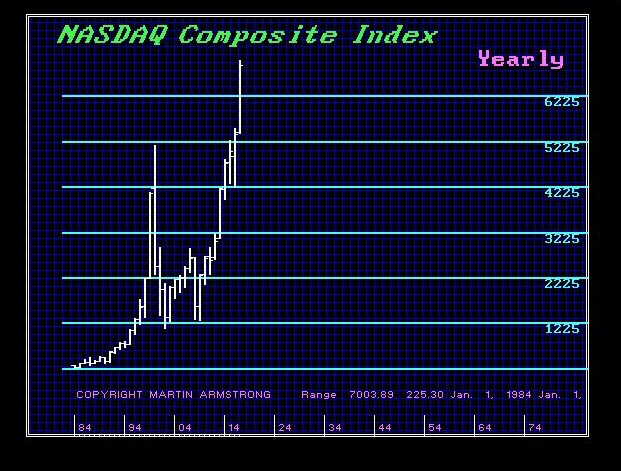QUESTION: Mr. Armstrong; I am impressed with your computer system for without historical data depth, it still manage to correctly forecast the high in Bitcoin. The BIS had come out against cryptocurrencies as has our central bank here in Switzerland calling them crude and unlikely to become a world currency without impressive advancement in the technology. With Bitcoin off more than 70% from the high, I am amazed that people keep calling for new highs. They did the same on gold. It appears to be some sort of emotional drug that these people get addicted to or are they just frauds?
Thank you
PVC
 ANSWER: The Global Market Watch is best on the higher levels. There are over 100,000 different patterns and it is still learning. It is matching patterns it discovers and when it discovers a new one, it records it and tests against it in the future. So it was able to forecast Bitcoin correctly from a pattern recognition perspective alone. That does not require heaps of historical data. It is a very interesting tool which completely evolves with time. I find it funny when people try to argue against it pointing their finger at me personally when it is the computer that is doing that job – not my personal opinion. The daily level is the most volatile for the complexity is off the charts. The reliability increases as we rise through the timing levels.
ANSWER: The Global Market Watch is best on the higher levels. There are over 100,000 different patterns and it is still learning. It is matching patterns it discovers and when it discovers a new one, it records it and tests against it in the future. So it was able to forecast Bitcoin correctly from a pattern recognition perspective alone. That does not require heaps of historical data. It is a very interesting tool which completely evolves with time. I find it funny when people try to argue against it pointing their finger at me personally when it is the computer that is doing that job – not my personal opinion. The daily level is the most volatile for the complexity is off the charts. The reliability increases as we rise through the timing levels.
Nevertheless, there are some people who miss the high and refuse to admit that they are wrong. You had people constantly calling for gold to take off for a 19 year decline. Even after the 2011 high, I got intense hate mail blaming me for the decline from these same type of people. They prefer to blame me rather than admit that they were investing emotionally, which is the worst strategy of all. I have stated before that when I was doing an institutional conference in Tokyo at the Imperial Hotel, a guy bribed his way in just to ask me what to do. He bought the Nikkei the very day of the high with $50 million and it was his very FIRST attempt at investing in stocks. He still had the position despite being down some 40% at the time.
 There is a basic rule that I have come to determine. A market can survive as long as the correction on a monthly level does not closed beyond 43% down from the high (8.6 /2). The next stage is 51.6%. Move beyond that and you cross into Meltdown Mode. Bitcoin crossed the 43% decline mark so that was a warning this was not a short-term correction from which new highs were possible. Moving beyond 51.6% meant that new highs are not likely for quite some time.
There is a basic rule that I have come to determine. A market can survive as long as the correction on a monthly level does not closed beyond 43% down from the high (8.6 /2). The next stage is 51.6%. Move beyond that and you cross into Meltdown Mode. Bitcoin crossed the 43% decline mark so that was a warning this was not a short-term correction from which new highs were possible. Moving beyond 51.6% meant that new highs are not likely for quite some time.
The Swiss National Bank has come out and stated it is not looking at cryptocurrencies and the blockchain technology for they consider them “far too crude” to support a digital franc. The Bank for International Settlements (BIS), the central bank to the central banks, has also come out with devastating prespective of the cryptocurrencies. They have highlighted the hacking and a number of perceived technical flaws as a major deterent to them advancing to a digital currency among nations. The BIS flat outright made it clear that they are too unsuitable to serve as a new global currency.
Of course, those who are the new crypto-believers will never yield. They believe what they WANT TO believe and close their minds to anything else. They analyze, forecast, and invest purely on emotion. Whenever emotions are involved, decisions will NEVER be prudent, wise, or successful. This seems to be some strange human flaw for it is by no means confined to cryptocurrencies. As I have stated before, this same type of pattern appears throughout history in everything from tulips, stocks, gold, silver, and DOT.COMs just to mention a few. However, like the DOT.COM Bubble, there is valid shifts in technology that will advance in the years ahead. The NASDAQ decline was 78.4% in two years 2000 to 2002 bottoming with the ECM turning point back then. Bitcoin dropped 69.06% in the first two months. June made a new low bringing the correction to 69.83%. It took the DOT.COM Bubble 18 months to reach that same percentage decline. It took the Japanese Nikkei 106 months to reach that percentage decline. For the 1929 Crash, it took 24 months to reach that same percentage decline. Therefore, it is abundantly clear that the losses in cryptocurrencies have dwarfed most other bubble declines and it reflects the skepticism inherent within as smart money realizes this is not going to circumvent central banks and bring governments to their knees.










